Popular categories
Looking for a yarn?

100% Wool
from 2.20 € /50g
Order DROPS Needles & Hooks
Clicking the ORDER button will redirect you to Saules siulas website
The yarn cost is calculated from the pattern’s smallest size and the yarn’s cheapest product type. Looking for an even better price? You might find it on the DROPS Deals!
Chaperon Bleu
Knitted jumper in DROPS Snow. The piece is worked bottom up in stocking stitch with raglan and a hood. Sizes S - XXXL.
DROPS Design: Pattern ee-738
Yarn group E or C + C
-------------------------------------------------------
SIZES:
S - M - L - XL - XXL - XXXL
MATERIALS:
DROPS SNOW from Garnstudio (belongs to yarn group E)
700-750-800-900-1000-1100 g colour 21, blue shadow
NEEDLES:
DROPS CIRCULAR NEEDLE SIZE 8 MM: Length 40 cm and 80 cm.
DROPS CIRCULAR NEEDLE SIZE 7 MM: Length 40 cm and 80 cm.
DROPS DOUBLE POINTED NEEDLES SIZE 8 MM.
DROPS DOUBLE POINTED NEEDLES SIZE 7 MM.
The technique MAGIC LOOP can be used – you then only need circular needle of 80 cm in each size.
KNITTING TENSION:
11 stitches in width and 15 rows in height with stocking stitch = 10 x 10 cm.
NOTE: Needle size is only a guide. If you get too many stitches on 10 cm, change to a larger needle size. If you get too few stitches on 10 cm, change to a smaller needle size.
-------------------------------------------------------
Alternative Yarn – See how to change yarns here
Yarn Groups A to F – Use the same pattern and change the yarn here
Yarn usage using an alternative yarn – Use our yarn converter here
-------------------------------------------------------
Women Jumpers Hooded Sweaters Chunky Knitsbottom up chunky knits hood raglan stocking stitch

100% Wool
from 2.20 € /50g
Order DROPS Needles & Hooks
Clicking the ORDER button will redirect you to Saules siulas website
The yarn cost is calculated from the pattern’s smallest size and the yarn’s cheapest product type. Looking for an even better price? You might find it on the DROPS Deals!
- English (UK/cm), Lithuania
- Česky
- Dansk
- Deutsch
- Eesti keel
- English (UK/cm)
- English (US/in)
- Español
- Français
- Íslenska
- Italiano
- Magyar
- Nederlands
- Norsk
- Polski
- Português
- Suomi
- Svenska
- English (UK/cm), Bulgaria
- English (UK/cm), Croatia
- English (UK/cm), Greece
- English (UK/cm), Latvia
- English (UK/cm), Romania
- English (UK/cm), Slovenia
- Česky, Slovakia
Pattern instructions
EXPLANATIONS FOR THE PATTERN:
-------------------------------------------------------
RIDGE/GARTER STITCH (worked back and forth):
Knit all rows.
1 ridge = knit 2 rows.
INCREASE TIP-1 (for sleeves):
Work until there are 2 stitches left before the marker, 1 yarn over, knit 4 (marker sits between these 4 stitches), 1 yarn over. On the next round knit the yarn overs twisted to avoid holes. Then work the new stitches in stocking stitch.
INCREASE TIP-2 (for hood):
Work until there are 2 stitches left before the marker thread, 1 yarn over, knit 4 (marker thread sits between these 4 stitches), 1 yarn over. On the next row work the yarn overs twisted to avoid holes. Then work the new stitches in stocking stitch.
RAGLAN:
Decrease to raglan in each transition between body and sleeves as follows: Work until there is 1 stitch left before marker-stitch, slip 2 stitches as if to knit together, knit 1, pass the slipped stitches over the knitted stitch. Repeat at each marker (8 stitches decreased on the row).
-------------------------------------------------------
START THE PIECE HERE:
-------------------------------------------------------
JUMPER - SHORT OVERVIEW OF THE PIECE:
The front and back pieces are worked separately, back and forth, bottom up until the split is finished. Both pieces are placed on the same circular needle and the piece is continued in the round as far as the armholes. The sleeves are worked in the round with double pointed needles/short circular needle, bottom up, then placed on the same circular needle as the body. The yoke is continued in the round. The hood is worked back and forth to finish.
BACK PIECE:
Cast on 62-70-74-78-86-94 stitches with circular needle size 7 mm and DROPS Snow. Purl 1 row from the wrong side. Then work rib as follows:
4 stitches in GARTER STITCH – read description above, * knit 2, purl 2 *, work from *-* until there are 6 stitches left, knit 2 and 4 stitches in garter stitch. Work this rib back and forth for 14 cm, finishing after a row from the wrong side. Lay the piece to one side.
FRONT PIECE:
Cast on and work in the same way as the back piece.
BODY:
Place the front and back pieces on the same circular needle size 8 mm and knit 1 round where you decrease 24-28-28-28-28-32 stitches evenly spaced = 100-112-120-128-144-156 stitches. Insert 1 marker at the beginning of the round and 1 marker after 50-56-60-64-72-78 stitches (sides). Work stocking stitch in the round. REMEMBER THE KNITTING TENSION!
When the piece measures 31 cm, cast off 6-6-6-8-8-10 stitches for the armholes on each side (cast off 3-3-3-4-4-5 stitches on each side of each marker) = 44-50-54-56-64-68 stitches on the front and back pieces. Lay the piece to one side and work the sleeves.
SLEEVES:
Cast on 32-32-36-36-40-40 stitches with double pointed needles size 7 mm and DROPS Snow. Knit 1 round, then work rib (knit 2, purl 2) in the round for 10 cm. Change to double pointed needles size 8 mm. Insert 1 marker at the beginning of the round (mid-under sleeve). Allow the marker to follow your work onwards; it is used when increasing under the sleeve. Work stocking stitch in the round. When the sleeve measures 12 cm from the cast-on edge, increase 1 stitch on each side of the marker – read INCREASE TIP. Increase like this every 8-6-7-4-3-2 cm a total of 4-5-4-6-7-10 times = 40-42-44-48-54-60 stitches. When the sleeve measures 42-40-38-37-35-34 cm, cast off 6-6-6-8-8-10 stitches under the sleeve (3-3-3-4-4-5 stitches on each side of the marker) = 34-36-38-40-46-50 stitches. Lay the piece to one side and work the other sleeve in the same way.
YOKE:
Place the sleeves onto the same circular needle as the body, where stitches were cast off for the armholes = 156-172-184-192-220-236 stitches. Insert 2 markers in the outermost stitch on each side of both the front and back pieces (4 markers). These are used when decreasing for raglan.
Start at the transition between the back piece and the right sleeve and work stocking stitch in the round. When the yoke measures 3-4-5-5-4-3 cm, begin to decrease for RAGLAN – read description above. Decrease like this every 2nd round a total of 11-12-13-14-17-19 times = 68-76-80-80-84-84 stitches.
Insert 1 marker-thread mid-front and 1 marker-thread mid-back. Cut the strand. Start 3 stitches before the marker-thread mid-front – the piece is now finished back and forth.
ROW 1 (right side): Knit and decrease for raglan until there are 3 stitches left before the marker-thread mid-front. Knit up 1 stitch behind each of the next 6 stitches. Turn.
ROW 2 (wrong side): Knit 5, purl until there are 5 stitches left, knit 5.
On the next row from the right side decrease for raglan for the last time (you have decreased a total of 13-14-15-16-19-21 times) and there are 58-66-70-70-74-74 stitches. The yoke measures approx. 21-23-25-27-29-31 cm.
HOOD:
Work stocking stitch with 5 stitches in garter stitch on each side, AT THE SAME TIME increase 1 stitch on each side of the marker-thread mid-back and 1 stitch on each side of both raglan-lines on the front piece (6 stitches increased) – read INCREASE TIP-2. Increase like this 1 more time on the next row from the right side = 70-78-82-82-86-86 stitches. Continue with stocking stitch and garter stitch until the hood measures 37-38-39-40-41-42 cm. Cast off.
Fold the hood and sew it together at the top.
I-CORD EDGE:
Work an edge around the hood as follows: Use 2 double pointed needles size 8 mm and cast on 2 stitches, knit up 1 stitch in the outermost loop of the bottom ridge on the right side of the hood (when the garment is worn) = 3 stitches on the needle.
*Push the stitches back to the beginning of the needle and work again from the right side without turning. Knit 2, slip the next stitch as if to knit, knit up a new stitch in the next ridge on the hood, pass the slipped stitch over the knitted-up stitch *, work from *-* until an edge has been worked around the hood. NOTE! Knit up 1 stitch in each ridge, if this makes the edge tight, knit up 1 more stitch evenly along the hood. Knit together the last 3 stitches on the row, cut the strand, pull it through the remaining stitch and fasten.
ASSEMBLY:
Sew the openings under the sleeves.
Diagram

What can you do with our patterns? You can share DROPS patterns online, using the pattern original picture, materials, name and number. But you are NOT ALLOWED to reproduce the complete pattern digitally in any way. Yarn stores are welcome to use the DROPS pattern database to promote the sale of our assortment. You can print out our patterns, make as many copies as you’d like. The only thing we ask is that you don't make any changes / additions to the original printed document. And that the patterns according to the DROPS philosophy are given out to the consumers for free. Editorials that wish to publish our patterns in printed books or magazines can contact us for more information. The sale of garments based on DROPS patterns is permitted as long as they are sold as single items or per order. Further commercial use of the patterns is not permitted. It has to be clearly stated that the garment is made based on a design from DROPS DESIGN. The use of clothing labels of which DROPS DESIGN forms part is conditioned by the inclusion of the following text: “A DROPS DESIGN made by …..”. The use of DROPS photos for marketing purposes/sales is only permitted in connection with the use/sale of DROPS products. The photos may not be cut or edited and the logo should be clearly visible.
We reserve the right to withdraw the permission for use of our patterns at any time, notwithstanding the reason.
Each of our patterns has specific tutorial videos to help you.
These step-by-step tutorials might also help you:
Why is the knitting/crochet tension so important?
Knitting tension is what determines the final measurements of your work, and is usually measured per 10 x 10 cm. It is provided like so: number of stitches in width x number of rows in height - eg: 19 stitches x 26 rows = 10 x 10 cm.
The knitting tension is very individual; some people knit/crochet loosely while others work tightly. You adjust the knitting tension with the needle size, which is why the suggested needle size is only meant as a guide! You need to adjust this (up or down) to ensure that YOUR knitting tension matches the knitting tension provided in the pattern. If you work with a different knitting tension than provided you will have a different yarn consumption, and your work will have different measurements than what the pattern suggests.
The knitting tension also determines which yarns can replace each other. As long as you achieve the same knitting tension you can replace one yarn with another.
See DROPS lesson: How to measure your tension/gauge
See DROPS video: How to make a gauge tension swatch
How do I know how many balls of yarn I need?
The required amount of yarn is provided in grams, eg: 450 g. To calculate how many balls you’ll need you first need to know how many grams are in 1 ball (25g, 50g or 100g). This information is available if you click on the individual yarn quality on our pages. Divide the amount required with the amount of each ball. For example, if each ball is 50g (the most common amount), the calculation will be as follows: 450 / 50 = 9 balls.
Can I use a different yarn than what the pattern suggests?
The important thing when changing from one yarn to another is that the knitting/crochet tension remains the same. This is so that the measurements of the finished piece will be the same as on the sketch provided. It is easier to achieve the same knitting tension using yarns from the same yarn group. It is also possible to work with multiple strands of a thinner yarn to achieve the knitting tension of a thicker one. Please try our yarn converter. We recommend you to always work a test swatch.
Please NOTE: when changing yarn the garment might have a different look and feel to the garment in the photo, due to individual properties and qualities of each yarn.
See DROPS lesson: Can I use a different yarn than the one mentioned in the pattern?
What are the yarn groups?
All our yarns are categorised into yarn groups (from A to F) according to thickness and knitting tension – group A contains the thinnest yarns and group F the thickest. This makes it easier for you to find alternative yarns to our patterns, should you wish to switch yarn. All yarns within the same group have a similar knitting tension and can easily replace each other. However, different yarn qualities have different structures and properties which will give the finished work a unique look and feel.
How do I use the yarn calculator?
At the top of all our patterns you’ll find a link to our yarn calculator, which is a helpful tool should you wish to use a different yarn than suggested. By filling in the yarn quality you wish to replace, the amount (in your size) and number of strands, the calculator will present good alternative yarns with the same knitting tension. Additionally it will tell you how much you’ll require in the new qualities and whether you’ll need to work with multiple strands. Most skeins are 50g (some are 25g or 100g).
If the pattern is worked with multiple colours, every colour will have to be calculated separately. Similarly, if the pattern is worked with several strands of different yarns (for example 1 strand Alpaca and 1 strand Kid-Silk) you will have to find alternatives for each, individually.
Why do you show discontinued yarns in the patterns?
Since different yarns have different qualities and textures we have chosen to keep the original yarn in our patterns. However, you can easily find options among our available qualities by using our yarn calculator, or simply pick a yarn from the same yarn group.
It is possible that some retailers still have discontinued yarns in stock, or that someone has a few skeins at home that they would like to find patterns for.
The yarn calculator will provide both alternative yarn as well as required amount in the new quality.
What size should I knit?
If you think it's hard to decide what size to make, it can be a good idea to measure a garment you own already and like the size of. Then you can pick the size by comparing those measures with the ones available in the pattern's size chart.
You'll find the size chart at the bottom of the pattern.
See DROPS lesson: How to read size chart
Why do I get the wrong knitting tension with the suggested needle size?
The needle size provided in the pattern serves only as a guide, the important thing is to follow the knitting tension. And since knitting tension is very individual, you will have to adjust the needle size to ensure that YOUR tension is the same as in the pattern – maybe you’ll have to adjust 1, or even 2 needle sizes, up or down to achieve the correct tension. For this, we recommend that you work test swatches.
Should you work with a different knitting tension than the one provided, the measurements of the finished garment might deviate from the measurement sketch.
See DROPS lesson: How to measure your tension/gauge
See DROPS video: How to make a tension/gauge swatch
Why is the pattern worked top-down?
Working a garment top-down provides more flexibility and room for personal adjustment. For example it is easier to try the garment on while working, as well as making adjustments to length of yoke and shoulder caps.
The instructions are carefully explaining every step, in the correct order. Diagrams are adjusted to the knitting direction and are worked as usual.
How do I work according to a knitting diagram?
The diagram depicts all rows/rounds, and every stitch seen from the right side. It is read from bottom to top, from right to left. 1 square = 1 stitch.
When working back and forth, every other row is worked from the right side and every other row is worked from the wrong side. When working from the wrong side, the diagram will have to be worked reversed: from left to right, knit stitches are purled, purl stitches are knit etc.
When working in the round every round is worked from the right side and the diagram are worked from right to left on all rounds.
See DROPS lesson: How to read knitting diagrams
How do I work according to a crochet diagram?
The diagram depicts all rows/rounds, and every stitch seen from the right side. It is worked from bottom to top, from right to left.
When working back and forth every other row is worked from the right side: from right to left and every other row is worked from the wrong side: from left to right.
When working in the round, every row in the diagram are worked from the right side, from right to left.
When working a circular diagram you start in the middle and work your way outwards, counter clockwise, row by row.
The rows usually start with a given number of chain stitches (equivalent to the height of the following stitch), this will either be depicted in the diagram or explained in the pattern.
See DROPS lesson: How to read crochet diagrams
How do I work several diagrams simultaneously on the same row/round?
Instructions for working several diagrams after each other on the same row/round, will often be written like so: “work A.1, A.2, A.3 a total of 0-0-2-3-4 times". This means you work A.1 once, then A.2 is worked once, and A.3 is repeated (in width) the number of times provided for your size – in this case like so: S = 0 times, M = 0 times, L=2 times, XL= 3 times and XXL = 4 times.
The diagrams are worked as usual: begin with the first row in A.1, then work the first row in A.2 etc.
See DROPS lesson: How to read knitting diagrams
See DROPS lesson: How to read crochet diagrams
Why are the sleeves shorter in larger sizes?
The total width of the garment (from wrist-to-wrist) will be larger in the larger sizes, despite the actual sleeves being shorter. The larger sizes have longer sleeve caps and wider shoulders, so there will be a good fit in all sizes.
Where on the garment is the length measured?
The measurement sketch/schematic drawing provides information regarding the full length of the garment. If it’s a jumper or a jacket the length is measured from the highest point on the shoulder closest to the neckline, and straight down to the bottom of the garment. It is NOT measured from the tip of shoulder. Similarly, the length of yoke is measured from the highest point on the shoulder and down to where yoke is split into body and sleeves.
On a jacket measures are never taken along bands, unless specifically stated. Always measure inside band stitches when measuring the length.
See DROPS lesson: How to read a schematic drawing
What is a repeat?
Diagrams are often repeated on the round or in height. 1 repeat is the diagram the way it appears in the pattern. If it says to work 5 repeats of A.1 in the round, then you work A.1 a total of 5 times after/next to each other in the round. If it says to work 2 repeats of A.1 vertically/in height you work the entire diagram once, then begin again at the start and work the entire diagram one more time.
Why does the piece start with more chain stitches than it’s worked with?
Chain stitches are slightly narrower than other stitches and to avoid working the cast-on edge too tight, we simply chain more stitches to begin with. The stitch count will be adjusted on the following row to fit the pattern and measurement sketch.
Why increase before the rib edge when the piece is worked top-down?
The rib edge is more elastic and will contract slightly compared to, for example, stocking stitch. By increasing before the rib edge, you avoid a visible difference in width between the rib edge and the rest of the body.
Why increase in the cast-off edge?
It’s very easy to cast off too tightly, and by making yarn overs while casting off (and simultaneously casting these off) you avoid a too tight cast off edge.
See DROPS video: How to bind off with yarn overs (yo)
How do I increase/decrease on every 3rd and 4th row/round alternately?
To achieve an even increase (or decrease) you can increase on, for example: every 3rd and 4th row alternately, like so: work 2 rows and increase on the 3rd row, work 3 rows and increase on the 4th. Repeat this until the increase is complete.
See DROPS lesson: Increase or decrease 1 st on every 3rd and 4th row alternately
How can I work a jacket in the round instead of back and forth?
Should you prefer to work in the round instead of back and forth, you may of course adjust the pattern. You’ll need to add steeks mid-front (usually 5 stitches), and follow the instructions. When you would normally turn and work from the wrong side, simply work across the steek and continue in the round. At the end you’ll cut the piece open, pick up stitches to work bands, and cover the cut edges.
See DROPS video: How to knit steeks and cut open
Can I work a jumper back and forth instead of in the round?
Should you prefer to work back and forth instead of in the round, you may of course adjust the pattern so you work the pieces separately and then assemble them at the end. Divide the stitches for the body in 2, add 1 edge stitch in each side (for sewing) and work the front and back pieces separately.
See DROPS lesson: Can I adapt a pattern for circular needles into straight needles?
Why is the pattern slightly different than what I see in the photo?
Pattern repeats can vary slightly in the different sizes, in order to get the correct proportions. If you’re not working the exact same size as the garment in the photo, yours might deviate slightly. This has been carefully developed and adjusted so that the complete impression of the garment is the same in all sizes.
Make sure to follow instructions and diagrams for your size!
How do I make a women’s size garment into a men’s size one?
If you have found a pattern you like which is available in women’s size it’s not very difficult to convert it to men’s size. The biggest difference will be the length of sleeves and body. Start working on the women size that you think would fit across the chest. The additional length will be worked right before you cast off for the armhole/sleeve cap. If the pattern is worked top-down you can add the length right after the armhole or before the first decrease on sleeve.
Regarding additional yarn amount, this will depend on how much length you add, but it is better with a skein too many than too few.
How do I prevent a hairy garment from shedding?
All yarns will have excess fibres (from production) that might come off as lint or shedding. Brushed yarns (ie hairier yarns) have more of these loose, excess fibres, causing more shedding.
Shedding also depends on what is worn under or over the garment, and whether this pulls at the yarn fibres. It’s therefore not possible to guarantee that there will be no shedding
Below are some tips on how to get the best result when working with hairier yarns:
1. When the garment is finished (before you wash it) shake it vigorously so the looser hairs come off. NOTE: do NOT use a lint roller, brush or any method that pulls at the yarn.
2. Place the garment in a plastic bag and put it in your freezer - the temperature will cause the fibres to become less attached to each other, and excess fibres will come off easier.
3. Leave in the freezer for a few hours before taking it out and shaking it again.
4. Wash the garment according to the instructions on the yarn label.
Why does my garment pill?
Pilling is a natural process that happens to even the most exclusive of fibers. It's a natural sign of wear and tear that is hard to avoid, and that is most visible in high friction areas of your garment like a sweater's arms and cuffs.
You can make your garment look as new by removing the pilling, using a fabric comb or a pill/lint remover.
In the meantime, you can read the questions and answers that others have left to this pattern or join the DROPS Workshop on Facebook to get help from fellow knitters/crocheters!
You might also like...
Chaperon Bleu |
|
 |
 |
Knitted jumper in DROPS Snow. The piece is worked bottom up in stocking stitch with raglan and a hood. Sizes S - XXXL.
DROPS 236-4 |
|
|
------------------------------------------------------- EXPLANATIONS FOR THE PATTERN: ------------------------------------------------------- RIDGE/GARTER STITCH (worked back and forth): Knit all rows. 1 ridge = knit 2 rows. INCREASE TIP-1 (for sleeves): Work until there are 2 stitches left before the marker, 1 yarn over, knit 4 (marker sits between these 4 stitches), 1 yarn over. On the next round knit the yarn overs twisted to avoid holes. Then work the new stitches in stocking stitch. INCREASE TIP-2 (for hood): Work until there are 2 stitches left before the marker thread, 1 yarn over, knit 4 (marker thread sits between these 4 stitches), 1 yarn over. On the next row work the yarn overs twisted to avoid holes. Then work the new stitches in stocking stitch. RAGLAN: Decrease to raglan in each transition between body and sleeves as follows: Work until there is 1 stitch left before marker-stitch, slip 2 stitches as if to knit together, knit 1, pass the slipped stitches over the knitted stitch. Repeat at each marker (8 stitches decreased on the row). ------------------------------------------------------- START THE PIECE HERE: ------------------------------------------------------- JUMPER - SHORT OVERVIEW OF THE PIECE: The front and back pieces are worked separately, back and forth, bottom up until the split is finished. Both pieces are placed on the same circular needle and the piece is continued in the round as far as the armholes. The sleeves are worked in the round with double pointed needles/short circular needle, bottom up, then placed on the same circular needle as the body. The yoke is continued in the round. The hood is worked back and forth to finish. BACK PIECE: Cast on 62-70-74-78-86-94 stitches with circular needle size 7 mm and DROPS Snow. Purl 1 row from the wrong side. Then work rib as follows: 4 stitches in GARTER STITCH – read description above, * knit 2, purl 2 *, work from *-* until there are 6 stitches left, knit 2 and 4 stitches in garter stitch. Work this rib back and forth for 14 cm, finishing after a row from the wrong side. Lay the piece to one side. FRONT PIECE: Cast on and work in the same way as the back piece. BODY: Place the front and back pieces on the same circular needle size 8 mm and knit 1 round where you decrease 24-28-28-28-28-32 stitches evenly spaced = 100-112-120-128-144-156 stitches. Insert 1 marker at the beginning of the round and 1 marker after 50-56-60-64-72-78 stitches (sides). Work stocking stitch in the round. REMEMBER THE KNITTING TENSION! When the piece measures 31 cm, cast off 6-6-6-8-8-10 stitches for the armholes on each side (cast off 3-3-3-4-4-5 stitches on each side of each marker) = 44-50-54-56-64-68 stitches on the front and back pieces. Lay the piece to one side and work the sleeves. SLEEVES: Cast on 32-32-36-36-40-40 stitches with double pointed needles size 7 mm and DROPS Snow. Knit 1 round, then work rib (knit 2, purl 2) in the round for 10 cm. Change to double pointed needles size 8 mm. Insert 1 marker at the beginning of the round (mid-under sleeve). Allow the marker to follow your work onwards; it is used when increasing under the sleeve. Work stocking stitch in the round. When the sleeve measures 12 cm from the cast-on edge, increase 1 stitch on each side of the marker – read INCREASE TIP. Increase like this every 8-6-7-4-3-2 cm a total of 4-5-4-6-7-10 times = 40-42-44-48-54-60 stitches. When the sleeve measures 42-40-38-37-35-34 cm, cast off 6-6-6-8-8-10 stitches under the sleeve (3-3-3-4-4-5 stitches on each side of the marker) = 34-36-38-40-46-50 stitches. Lay the piece to one side and work the other sleeve in the same way. YOKE: Place the sleeves onto the same circular needle as the body, where stitches were cast off for the armholes = 156-172-184-192-220-236 stitches. Insert 2 markers in the outermost stitch on each side of both the front and back pieces (4 markers). These are used when decreasing for raglan. Start at the transition between the back piece and the right sleeve and work stocking stitch in the round. When the yoke measures 3-4-5-5-4-3 cm, begin to decrease for RAGLAN – read description above. Decrease like this every 2nd round a total of 11-12-13-14-17-19 times = 68-76-80-80-84-84 stitches. Insert 1 marker-thread mid-front and 1 marker-thread mid-back. Cut the strand. Start 3 stitches before the marker-thread mid-front – the piece is now finished back and forth. ROW 1 (right side): Knit and decrease for raglan until there are 3 stitches left before the marker-thread mid-front. Knit up 1 stitch behind each of the next 6 stitches. Turn. ROW 2 (wrong side): Knit 5, purl until there are 5 stitches left, knit 5. On the next row from the right side decrease for raglan for the last time (you have decreased a total of 13-14-15-16-19-21 times) and there are 58-66-70-70-74-74 stitches. The yoke measures approx. 21-23-25-27-29-31 cm. HOOD: Work stocking stitch with 5 stitches in garter stitch on each side, AT THE SAME TIME increase 1 stitch on each side of the marker-thread mid-back and 1 stitch on each side of both raglan-lines on the front piece (6 stitches increased) – read INCREASE TIP-2. Increase like this 1 more time on the next row from the right side = 70-78-82-82-86-86 stitches. Continue with stocking stitch and garter stitch until the hood measures 37-38-39-40-41-42 cm. Cast off. Fold the hood and sew it together at the top. I-CORD EDGE: Work an edge around the hood as follows: Use 2 double pointed needles size 8 mm and cast on 2 stitches, knit up 1 stitch in the outermost loop of the bottom ridge on the right side of the hood (when the garment is worn) = 3 stitches on the needle. *Push the stitches back to the beginning of the needle and work again from the right side without turning. Knit 2, slip the next stitch as if to knit, knit up a new stitch in the next ridge on the hood, pass the slipped stitch over the knitted-up stitch *, work from *-* until an edge has been worked around the hood. NOTE! Knit up 1 stitch in each ridge, if this makes the edge tight, knit up 1 more stitch evenly along the hood. Knit together the last 3 stitches on the row, cut the strand, pull it through the remaining stitch and fasten. ASSEMBLY: Sew the openings under the sleeves. |
|

|
|
|
Have you made this or any other of our designs? Tag your pictures in social media with #dropsdesign so we can see them! Do you need help with this pattern?You'll find tutorial videos, a Comments/Questions area and more by visiting the pattern on garnstudio.com. © 1982-2024 DROPS Design A/S. We reserve all rights. This document, including all its sub-sections, has copyrights. Read more about what you can do with our patterns at the bottom of each pattern on our site. |
|
With over 40 years in knitting and crochet design, DROPS Design offers one of the most extensive collections of free patterns on the internet - translated to 17 languages. As of today we count 304 catalogues and 11415 patterns - 11415 of which are translated into English (UK/cm).
We work hard to bring you the best knitting and crochet have to offer, inspiration and advice as well as great quality yarns at incredible prices! Would you like to use our patterns for other than personal use? You can read what you are allowed to do in the Copyright text at the bottom of all our patterns. Happy crafting!







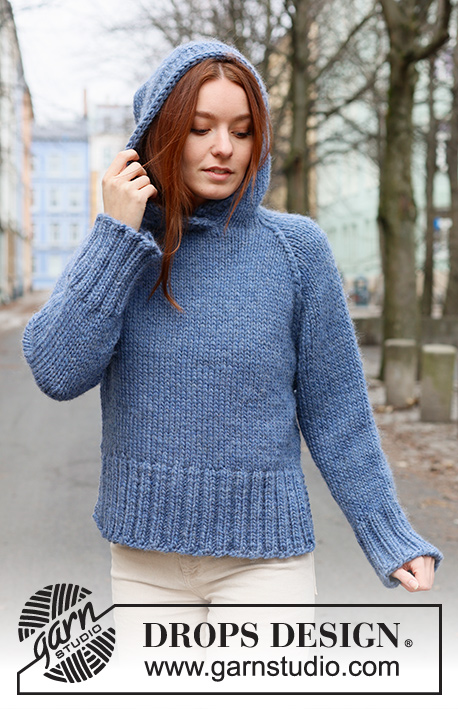
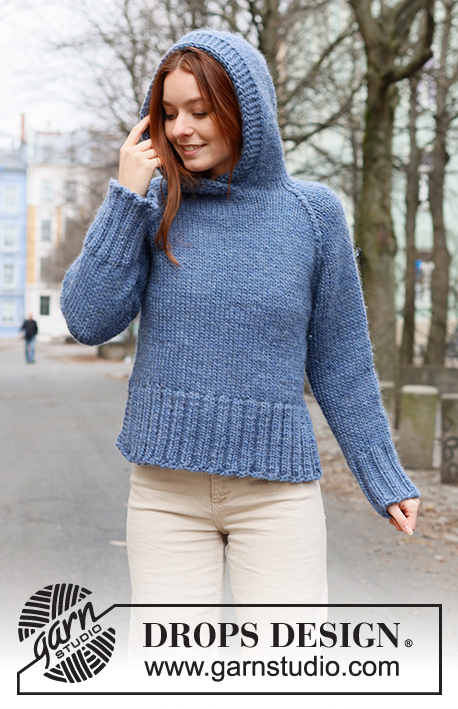
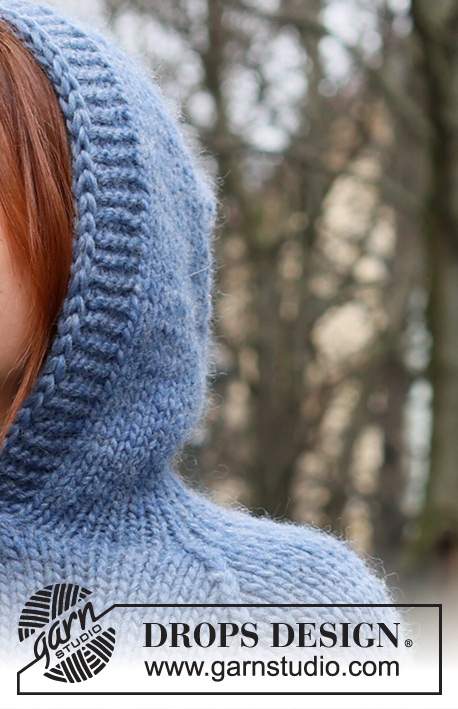



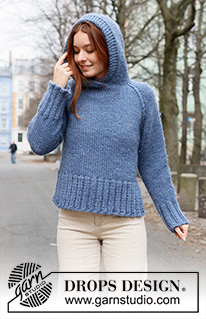
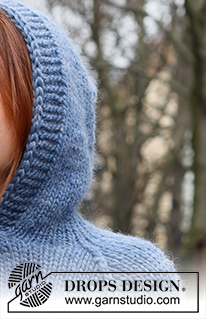




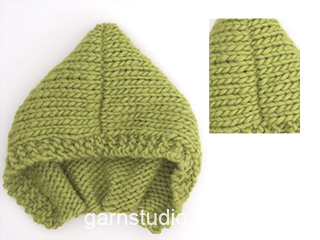


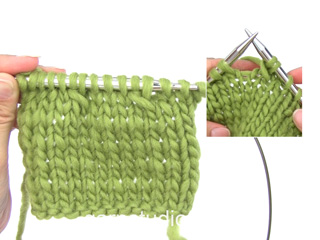





































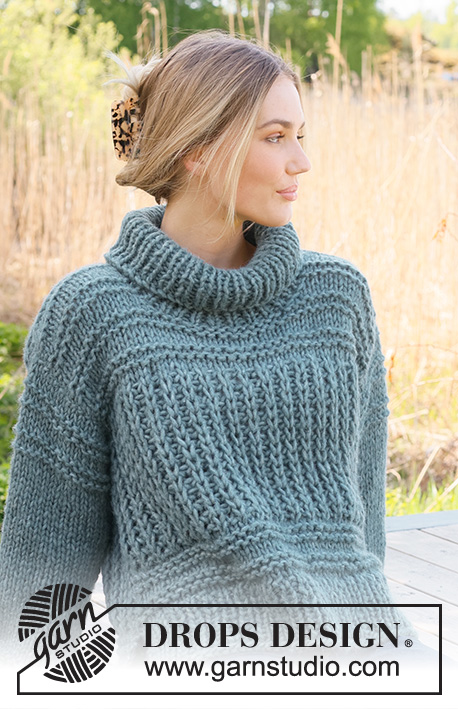








Comments / Questions (35)
Bærestykke: Jeg har strikke til Pinne 1(retten) "strikk opp 1 maske på baksiden av hver av de neste 6 maskene. Snu" Hva / hvordan gjør jeg det, menes det bakre ledd?
15.03.2024 - 22:01DROPS Design answered:
Hei Eli, Du skal strikke rett i både front- og bakledd i hver av de 6 maskene, slik at du øker 6 masker til kanten av hetta. God fornøyelse!
18.03.2024 - 07:00¿Cómo se teje al principio la capucha para que quede cruzada?
18.02.2024 - 00:20DROPS Design answered:
Hola Flor, cuando estás trabajando el raglán, después de las disminuciones tenías entre 68 y 84 puntos, dependiendo de la talla. Ahora insertas 1 hilo marcador y, a partir de ahí, comenzarás a trabajar la forma para que la capucha quede cruzada.
18.02.2024 - 22:55Bij de raglan mindering klopt het niet, kan toch niet bij voor de mouw én na de mouw hetzelfde in mindering .Wat gaat fout?
27.01.2024 - 20:58DROPS Design answered:
Dag Angela,
Je voegt de markeerdraden in de steken (en niet tussen de steken) en je meerdert in dit geval inderdaad op alle markeerdraden om dezelfde manier.
28.01.2024 - 18:39Como faço a Orla I-Cord? Podem explicar de maneira mais simples ou encaminhar um vídeo que explique? Obrigada.
24.12.2023 - 13:05DROPS Design answered:
Bom dia, Ao fundo da página com as explicações do modelo, encontra uma secção com vários tutoriais em vídeo, entre eles, um vídeo para explicar a orla I-Cord. Aqui está o vídeo; https://www.garnstudio.com/video.php?id=1727&lang=pt Bons tricôs!
09.01.2024 - 10:17Hallo, ich bin nun bei den Raglanabnahmen. Wo wandert der Markierungsfaden hin? Zwischen die zwei Abhebemaschen, nach die Abhebemaschen oder nach den Überzug? Und neigen sich bei dieser Technik nicht alle Abnahmen nach links? Theoretisch sollten sich die Abnahmen vor den Ärmeln doch nach links und nach den Ärmeln nach rechts neigen? Danke
17.12.2023 - 17:23DROPS Design answered:
Liebe Andy, der Markierungsfaden setzen Sie vor der Abnahme, damit die abgenommene Masche immer nach dem Markierungsfaden bleibt. In diesem Video zeigen wir, wie so eine Abnahme gestrickt wird. Viel Spaß beim stricken!
18.12.2023 - 09:03Moin, ich habe letztens eine Kapuze gestrickt, indem ich sie wie die Ferse bei einer Socke gearbeitet habe, das ginge doch bei diesem Modell sicherlich auch und man hätte nicht diese unschöne Mittelnaht! Gäbe es dafür eine Anleitung mit Maschenzahl usw? Liebe Grüße
13.12.2023 - 08:39DROPS Design answered:
Liebe Babsi, so was haben wir bei Pullover leider nicht, aber um eine Naht zu vermeiden können Sie die Maschen am Ende nicht abketten sonder mit Maschenstich zusammennähen - siehe Video. Viel Spaß beim stricken!
13.12.2023 - 16:13Bonjour, je coince sur les explications à partir ou il faut mettre les marqueurs mi dos et mi devant je ne comprends pas la suite pouvez vous m'expliquer comment faire après avoir mis les marqueurs? merci
11.12.2023 - 16:50DROPS Design answered:
Bonjour Mme Labaudre, une fois que vos marqueurs sont placés, coupez le fil. Vous allez maintenant tricoter non plus en rond mais en allers et retours à partir de l'encolure: en commençant 3 mailles avant le marqueur du milieu devant, tricotez toutes les mailles jusqu'à ces 3 mailles, vous relevez ensuite 1 maille derrière chacune des 6 mailles suivantes (fente d'encolure), tournez et tricotez le rang suivant sur l'envers, les 6 mailles côté encolure vont ainsi se chevaucher en bas de la fente d'encolure - retrouvez cette technique dans cette vidéo. Bon tricot!
12.12.2023 - 08:45Por favor suban un video donde se explique cómo empezar la capucha, porque para las principiantes no queda claro. Gracias.
09.12.2023 - 05:06I used the raglan ssk at each side of the sleeve, so 4 times in a round. But now I have 2 left leaning and 2 vertical decreases. Do I need twice the ssk and twice a k2tog to create the raglan sleaves? Ik heb de raglan instructie toegepast aan beide zijden van de mouwen, dus 4x per ronde. Nu heb ik 2 keer een schuine decrease en 2 keer een rechte decrease, waardoor de mouwen scheef zijn. Had ik een andere techniek moeten, gebruiken, met 2x ssk en 2x k2tog?
26.11.2023 - 10:03DROPS Design answered:
Dear Roosmarijn, this is not an ssk nor k2tog decrease (see RAGLAN above). You decrease 2 sts in each raglan line/ transition, so 8 sts in total on the row. You can see how to work this decrease here: https://www.garnstudio.com/video.php?id=736&lang=en. If you work in the same way in all of the raglan lines, the decreases should be equal in all lines. Happy knitting!
26.11.2023 - 22:45Skal bolen kun være 31 cm i alle størrelser? Er dette inklusive vrangborden?
09.11.2023 - 07:49DROPS Design answered:
Hei Veronika. Ja, det stemmer. Ønsker du den lengre (og har nok garn) kan du fint strikke den lengre. De 31 cm er inkl vrangborden. Se evnt. målene på målskissen lengst nederst på oppskriften. mvh DROPS Design
13.11.2023 - 11:57